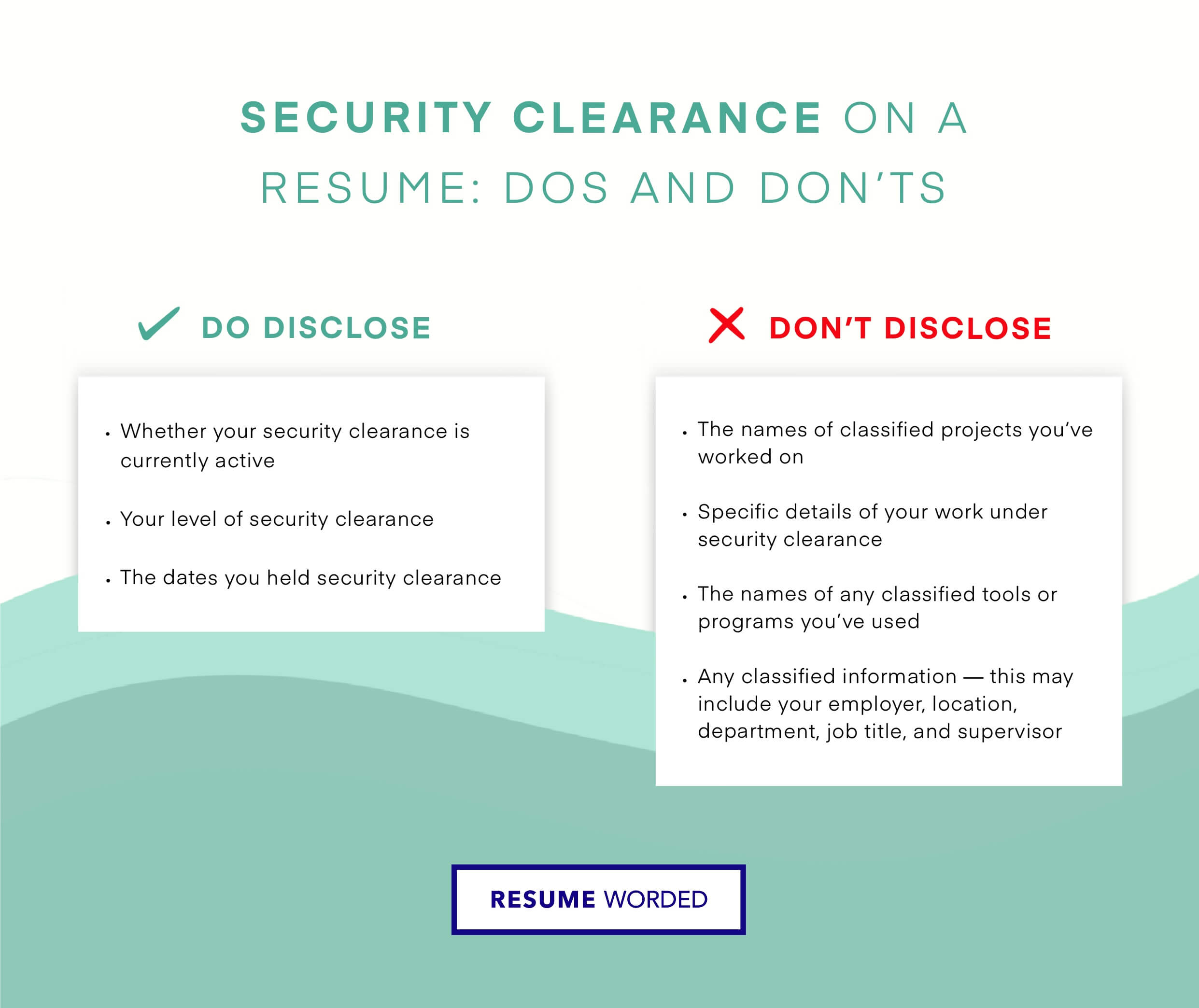How to list security clearance on resume – How to list security clearance on your resume is a crucial step in showcasing your qualifications for jobs requiring security clearance. Security clearance is a government-issued authorization that allows individuals access to classified information, and it is a valuable asset for those seeking employment in specific industries. Understanding how to present your security clearance effectively on your resume can significantly increase your chances of landing a job.
This guide will delve into the nuances of listing security clearance on your resume, providing best practices, formatting tips, and insights into the verification process. We’ll also explore the impact of security clearance on career advancement and address common challenges associated with maintaining a clearance.
Understanding Security Clearance

A security clearance is a formal authorization granted by a government agency to individuals who require access to classified information. This clearance indicates that the individual has been vetted and deemed trustworthy to handle sensitive materials.
Types of Security Clearances
Security clearances are categorized based on the sensitivity of the information they authorize access to. The most common types of security clearances in the United States include:
- Confidential: This is the lowest level of clearance and allows access to information that could cause “damage” to national security if disclosed. Examples of information classified at this level include operational plans, training materials, and some personnel data.
- Secret: This clearance authorizes access to information that could cause “serious damage” to national security if disclosed. Examples include intelligence reports, technical specifications for weapons systems, and some diplomatic communications.
- Top Secret: This is the highest level of clearance and authorizes access to information that could cause “exceptionally grave damage” to national security if disclosed. Examples include highly sensitive intelligence, classified research data, and strategic plans.
Importance of Security Clearances
Obtaining a security clearance is often a requirement for individuals seeking employment in specific industries and roles that involve handling classified information.
- National Security: Security clearances are crucial for protecting sensitive information related to national security. They help ensure that only authorized individuals have access to classified data, preventing unauthorized disclosure and potential harm to the country’s interests.
- Government Agencies: Many government agencies, including the Department of Defense, the intelligence community, and law enforcement agencies, require security clearances for their employees. These clearances are essential for maintaining the confidentiality and integrity of classified information handled by these agencies.
- Defense Contractors: Companies that contract with the government to provide defense-related services or products often require their employees to hold security clearances. This ensures that contractors have access to classified information necessary to fulfill their contracts and protect national security.
Industries and Roles Requiring Security Clearances
Security clearances are commonly required in industries and roles that handle sensitive information, including:
- Defense and Aerospace: This industry involves the development, production, and operation of military equipment and technologies. Security clearances are essential for individuals working on classified projects, such as weapons systems, aircraft design, and intelligence gathering.
- Intelligence: Intelligence agencies, such as the Central Intelligence Agency (CIA) and the National Security Agency (NSA), rely heavily on security clearances to protect their operations and sensitive information. Individuals working in intelligence roles, such as analysts, agents, and technical specialists, typically require clearances.
- Government Agencies: Many government agencies, including the Department of Homeland Security, the Department of State, and the Department of Justice, require security clearances for employees working in sensitive positions. These roles may involve handling classified information related to national security, law enforcement, or foreign policy.
- Cybersecurity: With the increasing threat of cyberattacks, cybersecurity professionals working for government agencies, defense contractors, and critical infrastructure providers often require security clearances. These clearances are necessary to access and analyze sensitive data related to cyber threats and vulnerabilities.
Listing Security Clearance on Your Resume

Highlighting your security clearance on your resume is crucial for landing jobs that require it. This section will guide you on how to effectively showcase your clearance to potential employers, ensuring your resume stands out.
Placement and Formatting
The best practice is to include your security clearance information in a dedicated section on your resume. This section should be prominently placed, either near the top or at the end of your resume, depending on your preference and the specific job you’re applying for. Ensure the section is clearly labeled and easy to read.
- Placement: You can choose to place the security clearance section after your contact information, summary, or skills section. Alternatively, you can place it at the end of your resume, right before your references.
- Formatting: Use bold text for the section title and clear bullet points for the details of your clearance. You can use a table format if you have multiple clearances to list.
Importance of Clear Information, How to list security clearance on resume
It’s essential to clearly state the following information to provide potential employers with a complete understanding of your clearance status:
- Clearance Level: Specify the highest level of clearance you hold, such as Top Secret, Secret, or Confidential. Avoid using abbreviations like TS, S, or C, as they might not be universally understood.
- Granting Agency: Mention the agency that granted you the clearance, such as the Department of Defense, Department of Energy, or the National Security Agency.
- Date of Last Investigation: Include the date of your last security clearance investigation. This shows employers that your clearance is current and valid.
Sample Security Clearance Section
Here are a few examples of how you can format your security clearance section on your resume:
Security Clearance
Top Secret, Department of Defense, Last Investigation: June 2023
Security Clearances
- Top Secret, Department of Energy, Last Investigation: December 2022
- Secret, Department of Homeland Security, Last Investigation: August 2021
Clearance Level Granting Agency Last Investigation Top Secret Department of Defense July 2023
Verifying Security Clearance

Potential employers will want to verify your security clearance before offering you a job. They need to ensure that your clearance is still active and valid, and that you meet their specific security requirements.
Verification Methods
Employers use a variety of methods to verify security clearances. These methods can include:
- Contacting the security clearance issuing agency. This is the most common method, as it provides the employer with the most reliable and up-to-date information.
- Requesting a copy of your security clearance certificate. This document will show your clearance level, date of issue, and any other relevant information.
- Checking your security clearance status online. Some security clearance issuing agencies have online databases that allow employers to verify clearance status.
- Using a third-party verification service. These services specialize in verifying security clearances and other credentials.
Additional Considerations
Beyond the mechanics of listing your security clearance on your resume, it’s crucial to understand the broader implications of holding a security clearance and how it impacts your career trajectory. A security clearance opens doors to specialized roles in various industries, but it also comes with responsibilities and potential challenges.
Impact on Career Advancement
Holding a security clearance can significantly enhance your career prospects, particularly in fields that require access to sensitive information. It can open doors to positions that would otherwise be inaccessible, leading to greater career opportunities and potential for advancement.
- Enhanced Job Opportunities: A security clearance expands your job search to include positions requiring access to classified information. This opens up a wider range of career paths, potentially leading to higher salaries and more fulfilling roles.
- Increased Salary Potential: Positions requiring security clearances often command higher salaries due to the specialized skills and responsibilities involved. This can be a significant advantage in your career advancement.
- Greater Career Mobility: Having a security clearance can make you a more attractive candidate to employers in various industries, enhancing your career mobility and opening up opportunities for relocation or career changes.
Challenges Associated with Maintaining a Security Clearance
Maintaining a security clearance involves ongoing responsibilities and potential challenges that you should be aware of. These factors can impact your personal and professional life and should be carefully considered.
- Background Checks: Regular background checks are required to ensure you continue to meet the security clearance standards. These checks can involve extensive scrutiny of your personal life, including financial history, travel records, and social media activity.
- Lifestyle Restrictions: Holding a security clearance may impose certain lifestyle restrictions, such as limitations on foreign travel, contact with foreign nationals, and participation in certain activities. These restrictions can affect your personal life and require careful planning.
- Potential for Revocation: A security clearance can be revoked if you fail to meet the required standards or engage in activities that compromise national security. This can have serious consequences for your career and future employment prospects.
Managing Security Clearance Requirements Throughout Your Career
Maintaining a security clearance is an ongoing process that requires proactive management. Here are some tips for navigating the requirements and ensuring the longevity of your clearance.
- Stay Informed: Familiarize yourself with the specific requirements and regulations associated with your security clearance. This includes understanding the potential risks and consequences of violating these regulations.
- Be Transparent: Be truthful and transparent with your employer and the security clearance authorities about any changes in your personal life or circumstances that could affect your clearance status. This includes changes in your financial situation, travel plans, or relationships.
- Seek Guidance: If you have any questions or concerns about your security clearance, don’t hesitate to seek guidance from your employer, security clearance officials, or a qualified professional.
By following these guidelines, you can effectively present your security clearance on your resume and increase your chances of securing employment in industries where it is a requirement. Remember, a well-crafted resume is a powerful tool that can showcase your qualifications and help you stand out from the competition.
FAQ Section: How To List Security Clearance On Resume
What if I have multiple security clearances?
List all of your clearances, starting with the highest level of clearance. Include the granting agency and the date of issuance for each clearance.
What if my clearance is currently under review?
You can mention that your clearance is currently under review, but it’s best to avoid including specific details. Focus on your skills and experience that are relevant to the position.
How do I know if a job requires a security clearance?
Look for s like “security clearance,” “Top Secret,” “Secret,” or “Confidential” in the job description. You can also contact the employer directly to inquire about security clearance requirements.






